M Charity
Amorphous Fortress Online: Collaboratively Designing Open-Ended Multi-Agent AI and Game Environments
Feb 08, 2025



Abstract:This work introduces Amorphous Fortress Online -- a web-based platform where users can design petri-dish-like environments and games consisting of multi-agent AI characters. Users can play, create, and share artificial life and game environments made up of microscopic but transparent finite-state machine agents that interact with each other. The website features multiple interactive editors and accessible settings to view the multi-agent interactions directly from the browser. This system serves to provide a database of thematically diverse AI and game environments that use the emergent behaviors of simple AI agents.
The Ink Splotch Effect: A Case Study on ChatGPT as a Co-Creative Game Designer
Mar 04, 2024Abstract:This paper studies how large language models (LLMs) can act as effective, high-level creative collaborators and ``muses'' for game design. We model the design of this study after the exercises artists use by looking at amorphous ink splotches for creative inspiration. Our goal is to determine whether AI-assistance can improve, hinder, or provide an alternative quality to games when compared to the creative intents implemented by human designers. The capabilities of LLMs as game designers are stress tested by placing it at the forefront of the decision making process. Three prototype games are designed across 3 different genres: (1) a minimalist base game, (2) a game with features and game feel elements added by a human game designer, and (3) a game with features and feel elements directly implemented from prompted outputs of the LLM, ChatGPT. A user study was conducted and participants were asked to blindly evaluate the quality and their preference of these games. We discuss both the development process of communicating creative intent to an AI chatbot and the synthesized open feedback of the participants. We use this data to determine both the benefits and shortcomings of AI in a more design-centric role.
Quality Diversity in the Amorphous Fortress (QD-AF): Evolving for Complexity in 0-Player Games
Dec 04, 2023



Abstract:We explore the generation of diverse environments using the Amorphous Fortress (AF) simulation framework. AF defines a set of Finite State Machine (FSM) nodes and edges that can be recombined to control the behavior of agents in the `fortress' grid-world. The behaviors and conditions of the agents within the framework are designed to capture the common building blocks of multi-agent artificial life and reinforcement learning environments. Using quality diversity evolutionary search, we generate diverse sets of environments. These environments exhibit certain types of complexity according to measures of agents' FSM architectures and activations, and collective behaviors. Our approach, Quality Diversity in Amorphous Fortress (QD-AF) generates families of 0-player games akin to simplistic ecological models, and we identify the emergence of both competitive and co-operative multi-agent and multi-species survival dynamics. We argue that these generated worlds can collectively serve as training and testing grounds for learning algorithms.
A Preliminary Study on a Conceptual Game Feature Generation and Recommendation System
Aug 16, 2023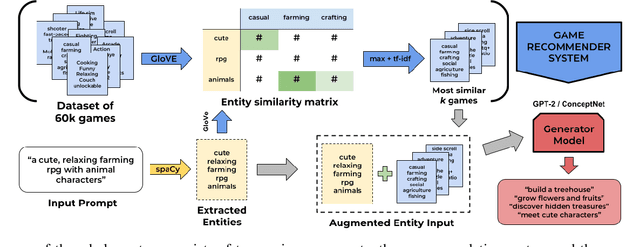
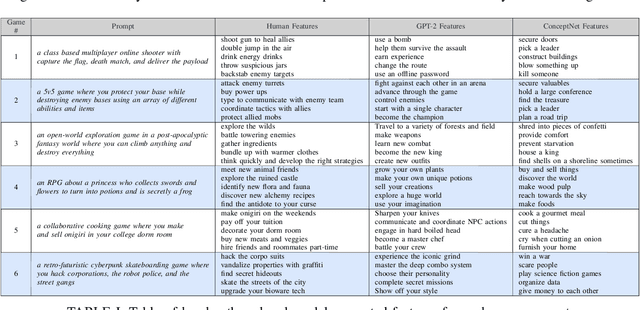
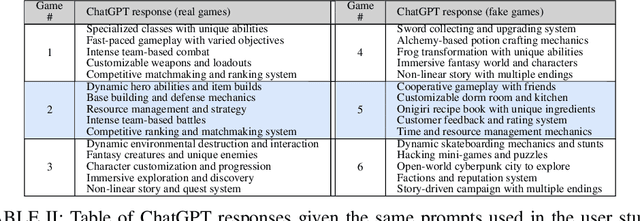
Abstract:This paper introduces a system used to generate game feature suggestions based on a text prompt. Trained on the game descriptions of almost 60k games, it uses the word embeddings of a small GLoVe model to extract features and entities found in thematically similar games which are then passed through a generator model to generate new features for a user's prompt. We perform a short user study comparing the features generated from a fine-tuned GPT-2 model, a model using the ConceptNet, and human-authored game features. Although human suggestions won the overall majority of votes, the GPT-2 model outperformed the human suggestions in certain games. This system is part of a larger game design assistant tool that is able to collaborate with users at a conceptual level.
The Five-Dollar Model: Generating Game Maps and Sprites from Sentence Embeddings
Aug 08, 2023



Abstract:The five-dollar model is a lightweight text-to-image generative architecture that generates low dimensional images from an encoded text prompt. This model can successfully generate accurate and aesthetically pleasing content in low dimensional domains, with limited amounts of training data. Despite the small size of both the model and datasets, the generated images are still able to maintain the encoded semantic meaning of the textual prompt. We apply this model to three small datasets: pixel art video game maps, video game sprite images, and down-scaled emoji images and apply novel augmentation strategies to improve the performance of our model on these limited datasets. We evaluate our models performance using cosine similarity score between text-image pairs generated by the CLIP VIT-B/32 model.
Amorphous Fortress: Observing Emergent Behavior in Multi-Agent FSMs
Jun 22, 2023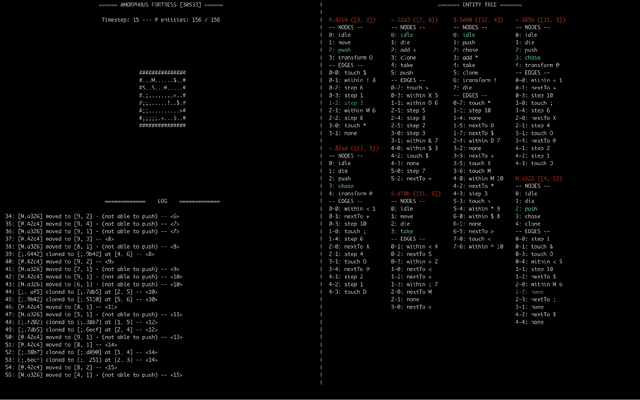
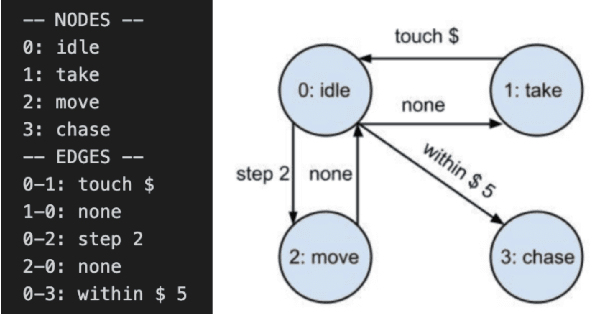
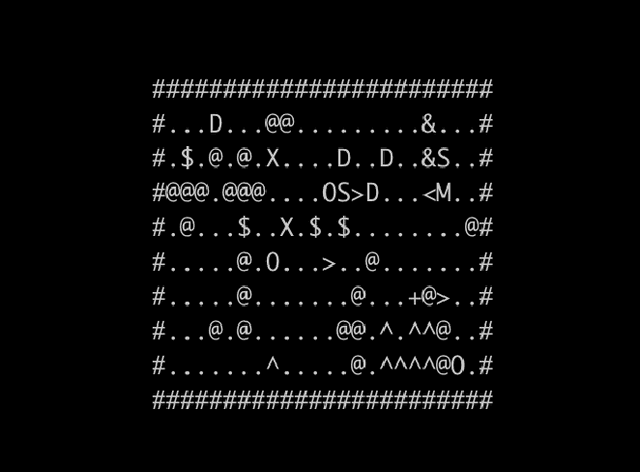

Abstract:We introduce a system called Amorphous Fortress -- an abstract, yet spatial, open-ended artificial life simulation. In this environment, the agents are represented as finite-state machines (FSMs) which allow for multi-agent interaction within a constrained space. These agents are created by randomly generating and evolving the FSMs; sampling from pre-defined states and transitions. This environment was designed to explore the emergent AI behaviors found implicitly in simulation games such as Dwarf Fortress or The Sims. We apply the hill-climber evolutionary search algorithm to this environment to explore the various levels of depth and interaction from the generated FSMs.
Keke AI Competition: Solving puzzle levels in a dynamically changing mechanic space
Sep 11, 2022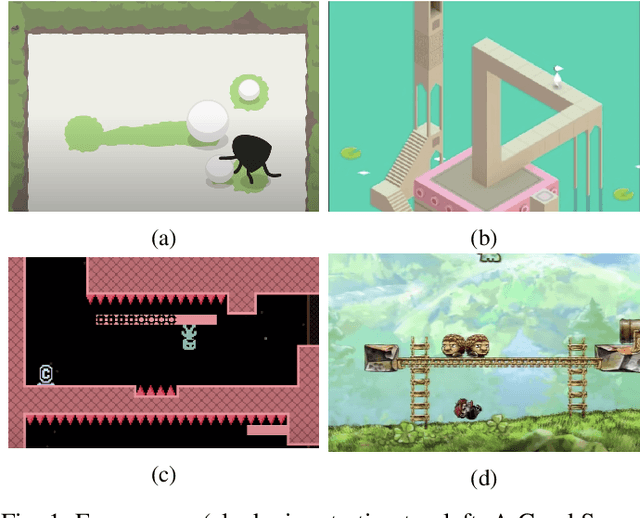
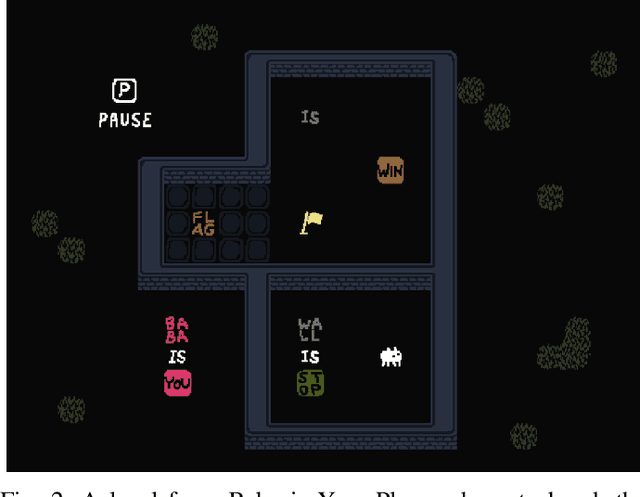
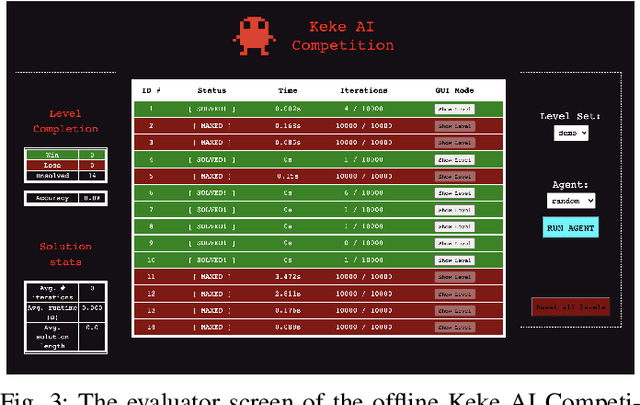
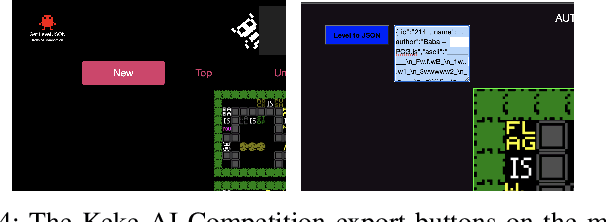
Abstract:The Keke AI Competition introduces an artificial agent competition for the game Baba is You - a Sokoban-like puzzle game where players can create rules that influence the mechanics of the game. Altering a rule can cause temporary or permanent effects for the rest of the level that could be part of the solution space. The nature of these dynamic rules and the deterministic aspect of the game creates a challenge for AI to adapt to a variety of mechanic combinations in order to solve a level. This paper describes the framework and evaluation metrics used to rank submitted agents and baseline results from sample tree search agents.
Diversity and Novelty MasterPrints: Generating Multiple DeepMasterPrints for Increased User Coverage
Sep 11, 2022



Abstract:This work expands on previous advancements in genetic fingerprint spoofing via the DeepMasterPrints and introduces Diversity and Novelty MasterPrints. This system uses quality diversity evolutionary algorithms to generate dictionaries of artificial prints with a focus on increasing coverage of users from the dataset. The Diversity MasterPrints focus on generating solution prints that match with users not covered by previously found prints, and the Novelty MasterPrints explicitly search for prints with more that are farther in user space than previous prints. Our multi-print search methodologies outperform the singular DeepMasterPrints in both coverage and generalization while maintaining quality of the fingerprint image output.
Aesthetic Bot: Interactively Evolving Game Maps on Twitter
Aug 24, 2022
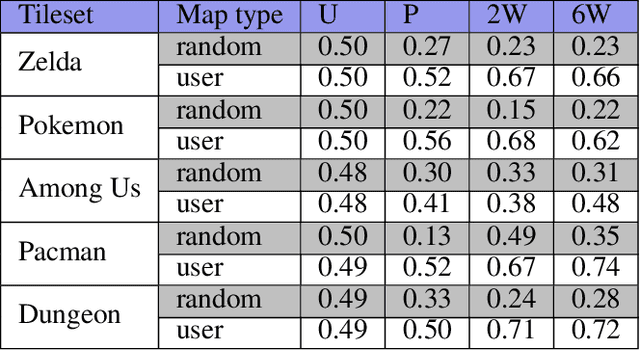


Abstract:This paper describes the implementation of the Aesthetic Bot, an automated Twitter account that posts images of small game maps that are either user-made or generated from an evolutionary system. The bot then prompts users to vote via a poll posted in the image's thread for the most aesthetically pleasing map. This creates a rating system that allows for direct interaction with the bot in a way that is integrated seamlessly into a user's regularly updated Twitter content feed. Upon conclusion of the each voting round, the bot learns from the distribution of votes for each map to emulate user preferences for design and visual aesthetic in order to generate maps that would win future vote pairings. We discuss the ongoing results and emerging behaviors that have occurred since the release of this system from both the bot's generation of game maps and the participating Twitter users.
Persona-driven Dominant/Submissive Map (PDSM) Generation for Tutorials
Apr 11, 2022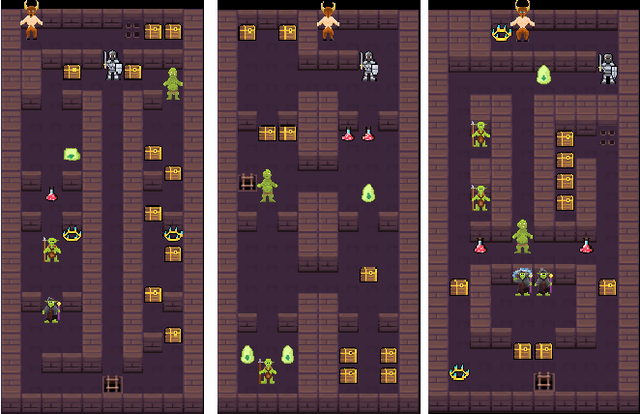



Abstract:In this paper, we present a method for automated persona-driven video game tutorial level generation. Tutorial levels are scenarios in which the player can explore and discover different rules and game mechanics. Procedural personas can guide generators to create content which encourages or discourages certain playstyle behaviors. In this system, we use procedural personas to calculate the behavioral characteristics of levels which are evolved using the quality-diversity algorithm known as Constrained MAP-Elites. An evolved map's quality is determined by its simplicity: the simpler it is, the better it is. Within this work, we show that the generated maps can strongly encourage or discourage different persona-like behaviors and range from simple solutions to complex puzzle-levels, making them perfect candidates for a tutorial generative system.
 Add to Chrome
Add to Chrome Add to Firefox
Add to Firefox Add to Edge
Add to Edge